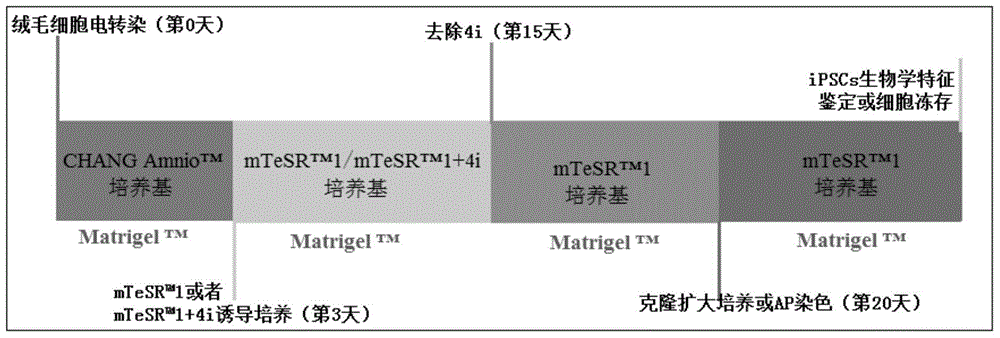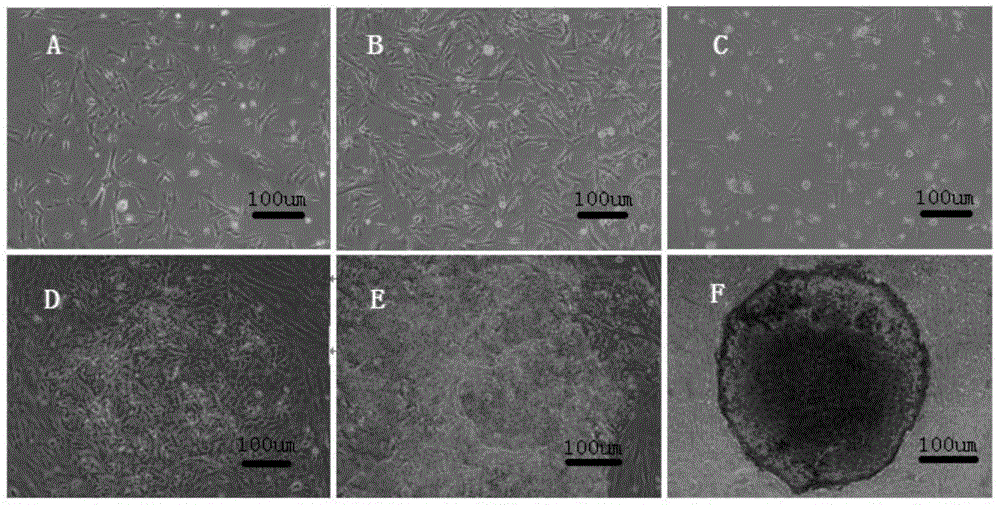Induced pluripotent stem cell (iPSC) and method for preparing same
A technology of pluripotent stem cells and cells, applied in the field of induced pluripotent stem cells and their preparation, can solve problems that need to be further studied, and achieve the effect of clear and smooth clone edges, tight and uniform cell arrangement, and large nucleus-to-cytoplasm ratio
- Summary
- Abstract
- Description
- Claims
- Application Information
AI Technical Summary
Problems solved by technology
Method used
Image
Examples
Embodiment 1
[0024] The collection of embodiment 1 reagent, experimental tool and experimental material
[0025]Villous cells: The villous tissue was extracted from the Reproductive Medicine Center of the Affiliated Hospital of Hainan Medical University under the guidance of B-ultrasound under sterile conditions, and isolated and cultured from Zhongyuan; the specimens were used after the informed consent of the donating couple was signed.
[0026] wxya TM 1 Preparation of working solution
[0027] The iPSC medium mTeSR used in subsequent examples TM 1 (StemCell) is a commercially produced medium, including mTeSR TM 1 basal and mTeSR TM 1 supplemental, according to the preparation method of the product manual: mix mTeSR TM 1 supplemental (100ml) was thawed overnight at 4°C, and the next day, in a biosafety cabinet, the thawed mTeSR TM 1supplemental added to mTeSR TM Mix well in 1 basal medium (400ml), dispense into 50ml centrifuge tubes (40ml / tube), store at -20°C, thaw at 4°C overnig...
Embodiment 2
[0067] Example 2 Induction of Villus Cells Induced Pluripotent Stem Cells (iPSCs)
[0068] In this example, a plasmid containing cDNA or miRNA clusters of pluripotent stem cell-inducing factors was introduced into the villous cells obtained in Step 1 by electroporation, and the pluripotent stem cell-inducing factors used were OCT4 and SOX2 , SV40LT, KLF4 and the combination of microRNA302-367. Then, the villous cells introduced into the cell-free feeder layer, CHANG Amnio TM Cultured in the medium environment, and then transferred to the human embryonic stem cell culture environment without serum and cell feeder layer. After 20 days of culture, a large number of primitive induced pluripotent stem cell clones with typical growth were obtained, and these clones were picked and continued to culture. The specific operation steps are as follows:
[0069] (1) 2-3 days before electroporation, the cells were thawed or subcultured until the cell density was about 70%-85% before trans...
Embodiment 3
[0088] Example 3 Passage and maintenance of villus induced pluripotent stem cells
[0089] In this example, iPSCs were passaged mechanically at the initial stage of cloning, purification and passaging. When the iPSC clone grows about 1mm in diameter and has a certain thickness, it can be passaged; the specific operation steps are as follows:
[0090] (1) Cut the cell clones into equal-sized cell clumps (each cell clump is about 300-600 microns in size) under a dissecting microscope using the previously prepared glass tube.
[0091] (2) Use a 10 microliter pipette tip to transfer these cell masses to the prepared culture dish in advance, place them in an incubator for culture, and complete passage.
[0092] The status of cell clones before and after mechanical passage is as follows: Figure 4 -A and Figure 4 -A'shown, Figure 4 -A is the state of the clone before mechanical purification: the white place in the middle of the clone and the scattered cells around it are diffe...
PUM
| Property | Measurement | Unit |
|---|---|---|
| Diameter | aaaaa | aaaaa |
Abstract
Description
Claims
Application Information
 Login to View More
Login to View More - R&D
- Intellectual Property
- Life Sciences
- Materials
- Tech Scout
- Unparalleled Data Quality
- Higher Quality Content
- 60% Fewer Hallucinations
Browse by: Latest US Patents, China's latest patents, Technical Efficacy Thesaurus, Application Domain, Technology Topic, Popular Technical Reports.
© 2025 PatSnap. All rights reserved.Legal|Privacy policy|Modern Slavery Act Transparency Statement|Sitemap|About US| Contact US: help@patsnap.com



